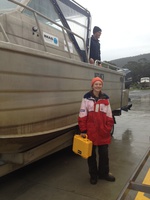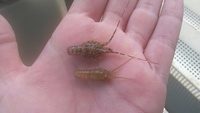Whale poo, lobster babies and fish ears: a week at IMAS
The Redmap Team, 06 Jul 2016.
Year 10 student Georgia Poyner from Narooma, NSW, donned a lab coat and wet weather gear for an action-packed week of field and lab experience at the Institute for Marine and Antarctic Studies (IMAS) in Hobart recently. She measured rock lobsters, cut out fish ears and discovered what whale poop looks like.
Finding a way to IMAS
Teenager Georgia is an avid scuba diver and one of Redmap’s top contributors of uncommon marine sightings. So it’s no surprise she was keen to work with IMAS marine researchers at the University of Tasmania.
Georgia was awarded a Layne Beachley (Aim for the Stars) Foundation grant with the help of IMAS researcher and Redmap coordinator Dr Jemina Stuart-Smith. This allowed Georgia to travel to Hobart for a week of field and lab work.
Not just microscopes – there’s whale poo too!
Georgia toured the IMAS laboratories and removed the “ears” from snapper and kingfish with phD student Curtis Champion (by the way a fish ear, or otolith, is extracted to estimate the age of a fish).
But an experience that sticks in her mind is discovering what frozen whale poop looks like.
Georgia explains matter-of-factly why Lavenia Ratnarajah stores whale faeces in the IMAS lab freezers: “Lavy is a researcher studying whale poo.”
Lavy’s PhD looks into how whales help feed the ocean. Phytoplankton are the main food source that supports all marine life and in turn whale poop influences phytoplankton growth and removes carbon dioxide from the atmosphere in the Southern Ocean. Read more in The Conversation.
Who says science is dull?
Fieldwork rocks lobsters!
But back to Georgia: another highlight was hitching a ride on the IMAS boat to help research divers measure rock lobsters from an artificial reef south of Hobart.
“The artificial reef holds juvenile southern rock lobsters which had be tagged and released there a year ago,” Georgia says.
Georgia measured the rock lobsters and recorded any tags on the lobsters. This research helps track the fate of both resident lobsters and new recruits and other factors like lobster growth rates.
Georgia also learned about Redmap and another citizen science program Reef Life Survey.
The darker side of science
Georgia’s enthusiasm for science could not be tempered, even after cleaning crates south of Hobart, which are used as the artificial habitat for rock lobster babies (known as ‘puerulus larvae’).
“The crates have lots of organisms growing on them which are not wanted so my job was to try and clean them. It was fun but a messy job,” Georgia says.
“I also got to see a few of the puerulus which looked exactly like what adult lobsters look like except clear and tiny.”
Enjoying the less glamorous side of research means Georgia is truly a scientist in the making!
Find out more about IMAS
IMAS offers a number of ways for students to check out what marine scientists do:
• Year 11 and 12 students around Australia can apply for a field-intensive marine biology experience on Maria Island in Tasmania. The week-long course and fieldwork are run twice a year by IMAS and the University of Tasmania. For more information: XAS101 A Practical Introduction to Temperate Marine Biology.
• University of Tasmania Open Days in Hobart, Launceston and Burnie on 7 August 2016
• University of Tasmania Open Days in Darlinghurst on 27th August and Rozelle on 28 August 2016
• Volunteering and work experience
• And keep up-to-date with recent IMAS research at www.imas.utas.edu.au and on Facebook.
Thanks to IMAS staff: Mike Porteus, Dr Rick Stuart-Smith, Graeme Ewing, Dr Sean Tracey, Dr Jayson Semmens, Vallorie Hodges, Sarah-Jane Pyke, Ruari Colquhuon, Lisette Robertson, Dr Scott Ling, Yvette Barry, Dr Natalia Atkins (IMOS), EAF staff, and PhD students Lavy Ratnarajah, Curtis Champion.













